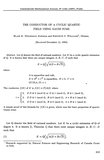Article
Full entry |
 PDF
(0.8 MB)
Feedback
PDF
(0.8 MB)
Feedback
 PDF
(0.8 MB)
Feedback
PDF
(0.8 MB)
Feedback
Summary:
Let $Q$ denote the field of rational numbers. Let $K$ be a cyclic quartic extension of $Q$. It is known that there are unique integers $A$, $B$, $C$, $D$ such that \[ K=Q\Big (\sqrt{A(D+B\sqrt{D})}\Big ), \] where \[ A \ \text{is squarefree and odd}, D=B^2+C^2 \ \text{is squarefree}, \ B>0, \ C>0, GCD(A,D) = 1. \] The conductor $f(K)$ of $K$ is $f(K) = 2^l|A|D$, where \[ l= \begin{cases} 3, \quad \text{if} \ D\equiv 2 \pmod 4 \ \text{or} \ D \equiv 1 \pmod 4, \ B \equiv 1 \pmod 2, \\ 2, \quad \text{if} \ D\equiv 1 \pmod 4, \ B \equiv 0 \pmod 2, \ A + B \equiv 3 \pmod 4, \\ 0, \quad \text{if} \ D\equiv 1 \pmod 4, \ B \equiv 0 \pmod 2, \ A + B \equiv 1 \pmod 4. \end{cases} \] A simple proof of this formula for $f(K)$ is given, which uses the basic properties of quartic Gauss sums.
References:
[1] K. Hardy, R.H. Hudson, D. Richman, K.S. Williams and N.M. Holtz: Calculation of the class numbers of imaginary cyclic quartic fields. Carleton-Ottawa Mathematical Lecture Note Series (Carleton University, Ottawa, Ontario, Canada), Number 7, July 1986, pp. 201. MR 0906194
[2] K. Ireland and M. Rosen: A Classical Introduction to Modern Number Theory. Springer-Verlag, New York, Second Edition (1990). MR 1070716

